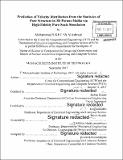| dc.contributor.advisor | Ruben Juanes. | en_US |
| dc.contributor.author | AlAdwani, Mohammad S. Kh. F. Sh | en_US |
| dc.contributor.other | Massachusetts Institute of Technology. Computation for Design and Optimization Program. | en_US |
| dc.date.accessioned | 2018-03-02T22:21:25Z | |
| dc.date.available | 2018-03-02T22:21:25Z | |
| dc.date.copyright | 2017 | en_US |
| dc.date.issued | 2017 | en_US |
| dc.identifier.uri | http://hdl.handle.net/1721.1/113977 | |
| dc.description | Thesis: S.M., Massachusetts Institute of Technology, Department of Electrical Engineering and Computer Science, 2017. | en_US |
| dc.description | Thesis: S.M., Massachusetts Institute of Technology, Computation for Design and Optimization Program, 2017. | en_US |
| dc.description | Cataloged from PDF version of thesis. | en_US |
| dc.description | Includes bibliographical references (pages 57-60). | en_US |
| dc.description.abstract | Fluid flow and particle transport through porous media are determined by the geometry of the host medium itself. Despite the fundamental importance of the velocity distribution in controlling early-time and late-time transport properties (e.g., early breakthrough and superdiffusive spreading), direct relations linking velocity distribution with the statistics of pore structure in 3D porous media have not been established yet. High velocities are controlled by the formation of channels, while low velocities are dominated by stagnation zones. Recent studies have proposed phenomenological models for the distribution of high velocities including stretched exponential and power-exponential distributions but without an underlying mechanistic or statistical physics theory. Here, we investigate the relationship between the structure of the host medium and the resulting fluid flow in random dense spherical packs. We simulate flow at low Reynolds numbers by solving the Stokes equations with the finite volume method and imposing a no-slip boundary condition at the boundary of each sphere. High fidelity numerical simulations of Stokes flow are facilitated with the assist of open source Computational Fluid Dynamics (CFD) tools such as OpenFOAM. We show that the distribution of low velocities in 3D porous media is described by a Gamma distribution, which is robust to variations in the geometry of the porous media. We develop a simple model that predicts the parameters of the gamma distribution in terms of the porosity of the host medium. Despite its simplicity, the analytical predictions from the model agree well with high-resolution simulations in terms of velocity distribution. | en_US |
| dc.description.statementofresponsibility | by Mohammad S Kh F Sh AlAdwani. | en_US |
| dc.format.extent | 60 pages | en_US |
| dc.language.iso | eng | en_US |
| dc.publisher | Massachusetts Institute of Technology | en_US |
| dc.rights | MIT theses are protected by copyright. They may be viewed, downloaded, or printed from this source but further reproduction or distribution in any format is prohibited without written permission. | en_US |
| dc.rights.uri | http://dspace.mit.edu/handle/1721.1/7582 | en_US |
| dc.subject | Electrical Engineering and Computer Science | en_US |
| dc.subject | Computation for Design and Optimization Program. | en_US |
| dc.title | Prediction of velocity distribution from the statistics of pore structure in 3D porous media via high-fidelity pore-scale simulation | en_US |
| dc.type | Thesis | en_US |
| dc.description.degree | S.M. | en_US |
| dc.contributor.department | Massachusetts Institute of Technology. Computation for Design and Optimization Program | en_US |
| dc.contributor.department | Massachusetts Institute of Technology. Department of Electrical Engineering and Computer Science | en_US |
| dc.identifier.oclc | 1023628080 | en_US |
